California is home to a wide variety of spiders, most of which are harmless, but some are venomous and can inflict a nasty bite. Some of these spiders may be living in your home, hiding in dark corners, under furniture, or in closets. Knowing how to identify these common California spiders can help you avoid unwanted encounters and deal with them appropriately. Here are 10 common spiders that you may find in your home in California.
Most Common Spiders in Southern California
1. Banded Garden Spider
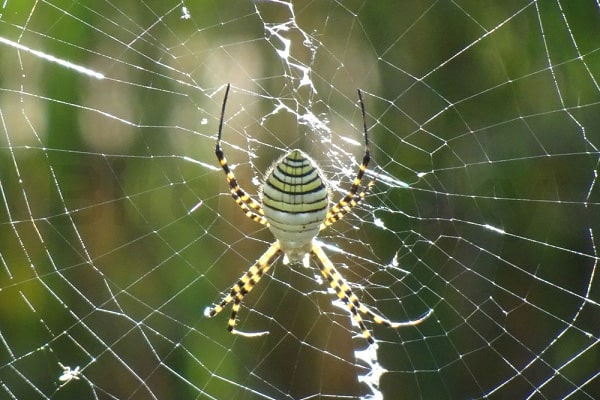
The banded garden spider (Argiope trifasciata) is a large and colorful orb-weaver spider that builds intricate webs in gardens, fields, and shrubs. The spider has a black and yellow striped abdomen, a silver head, and black and white banded legs. The female is much larger than the male, reaching up to an inch in body length, while the male is only about a quarter of an inch.
The banded garden spider is not aggressive and will only bite if provoked or threatened. The bite is not dangerous to humans but may cause some pain, swelling, and itching. The spider is beneficial to the environment, as it feeds on insects and pests that may damage crops and plants.
2. Johnson’s Jumping Spider
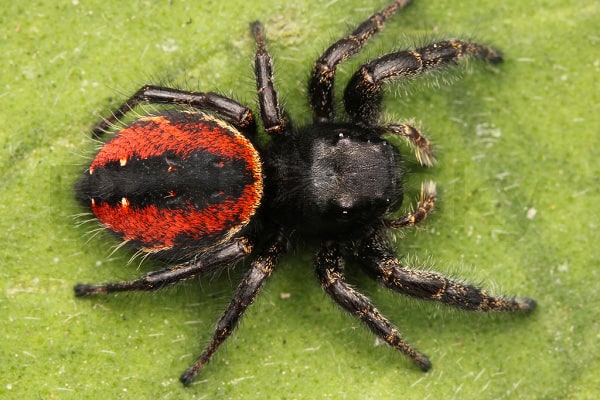
The Johnson’s jumping spider (Phidippus johnsoni) is a small and fuzzy spider that belongs to the family Salticidae, which are known for their excellent vision and jumping ability. The spider has a black body with a red or orange abdomen and four large eyes on the front of its head. The female is slightly larger than the male, reaching up to half an inch in body length, while the male is about a third of an inch.
The Johnson’s jumping spider is not dangerous to humans, and will usually avoid contact. The bite is rare and mild, causing only minor pain and redness. The spider is active during the day, and can be seen hunting for insects and spiders on walls, fences, and plants.
You may want to read: Hummingbird Eggs
3. Grass Spider
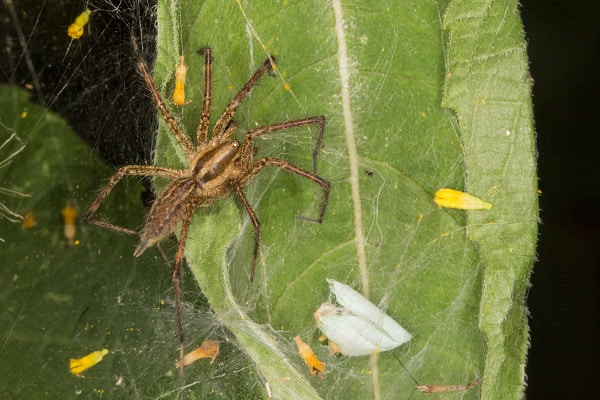
The grass spider (Agelenopsis spp.) is a common and widespread spider that belongs to the family Agelenidae, which is known for their funnel-shaped webs. The spider has a brown or gray body with dark stripes on its cephalothorax and long and hairy legs. The female is larger than the male, reaching up to three-quarters of an inch in body length, while the male is about half an inch.
The grass spider is not aggressive and will only bite if disturbed or handled. The bite is not harmful to humans but may cause some pain and inflammation. The spider is mostly nocturnal and can be found in grassy areas, under rocks, and in basements and garages.
4. Cellar Spider

The cellar spider (Pholcus phalangioides) is a slender and pale spider that belongs to the family Pholcidae, which are also known as daddy long-leg spiders. The spider has a small and oval body and extremely long and thin legs. The female is slightly larger than the male, reaching up to a quarter of an inch in body length, while the male is about an eighth of an inch.
The cellar spider is not venomous and will not bite humans. The spider is harmless and beneficial, as it feeds on other spiders and insects that may be pests in the house. The spider is usually found in dark and damp places, such as cellars, attics, closets, and bathrooms.
Must Read Interesting Cardinal Bird Facts
5. Yellow Sac Spider

The yellow sac spider (Cheiracanthium mildei) is a small and light-colored spider that belongs to the family Eutichuridae, which are also known as sac spiders. The spider has a yellow or beige body, and dark brown or black markings on its legs and mouthparts. The female is larger than the male, reaching up to a third of an inch in body length, while the male is about a quarter of an inch.
The yellow sac spider is one of the most common spiders that bite humans in California. The bite is painful and can cause swelling, redness, and blistering. In some cases, the bite may also cause nausea, fever, and necrosis. The spider is active at night, and can be found in various habitats, such as gardens, fields, forests, and houses. The spider makes a silk sac in which it rests during the day, often in hidden places, such as under furniture, in curtains, or in clothing.
6. Wolf Spider California
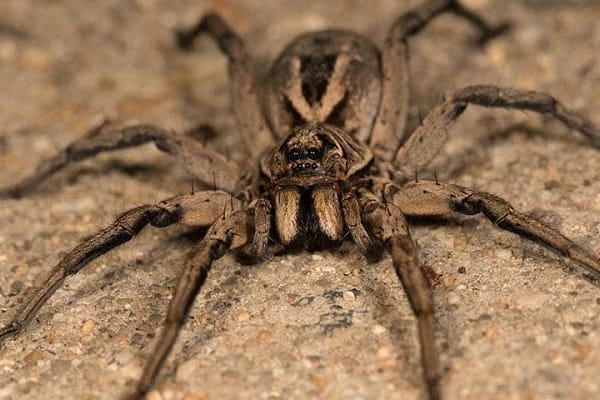
The wolf spider (Hogna antelucana) is a large and hairy spider that belongs to the family Lycosidae, which are also known as hunting spiders. The spider has a brown or gray body, with dark markings on its cephalothorax and abdomen, and yellow or orange rings on its legs. The female is larger than the male, reaching up to an inch and a half in body length, while the male is about an inch.
The wolf spider is not aggressive and will only bite if provoked or threatened. The bite is not dangerous to humans but may cause some pain, swelling, and itching. The spider is mostly nocturnal and can be seen hunting for insects and spiders on the ground, in leaf litter, and in burrows.
Also Visit Black Birds In Florida
7. California Tarantula

The California tarantula (Aphonopelma johnnycashi) is a massive and hairy spider that belongs to the family Theraphosidae, which are also known as tarantulas. The spider has a black body, with brown or reddish hairs on its legs and abdomen. The female is larger than the male, reaching up to three inches in body length, while the male is about two inches.
The California tarantula is not aggressive and will only bite if provoked or threatened. The bite is not dangerous to humans but may cause some pain and discomfort. The spider is mostly nocturnal and can be found in dry and rocky areas, such as deserts, grasslands, and mountains. The spider makes a silk-lined burrow in which it lives and may emerge during the mating season, which is from August to October.
8. Black Widow Spider in California
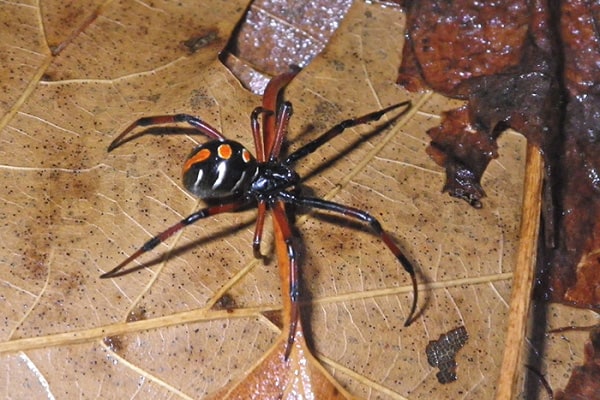
The black widow spider (Latrodectus hesperus) is a notorious and venomous spider that belongs to the family Theridiidae, which are also known as cobweb spiders. The spider has a glossy black body, with a distinctive red hourglass mark on its abdomen. The female is much larger than the male, reaching up to half an inch in body length, while the male is only about a quarter of an inch.
The black widow spider is one of the most dangerous spiders in California, as its bite can cause severe pain, muscle spasms, nausea, vomiting, and difficulty breathing. In rare cases, the bite can be fatal, especially to young children, elderly people, and people with medical conditions. The spider is shy and will only bite if disturbed or threatened. The spider is usually found in dark and secluded places, such as under rocks, in woodpiles, in sheds, and in basements.
You may want to explore Purple Bird Species
9. Brown Widow Spider in California
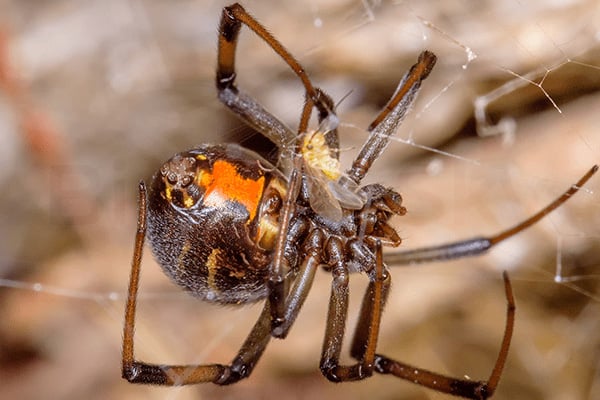
The brown widow spider (Latrodectus geometricus) is a close relative of the black widow spider and also belongs to the family Theridiidae. The spider has a brown or gray body, with black and white markings on its cephalothorax, and an orange or yellow hourglass mark on its abdomen. The female is larger than the male, reaching up to half an inch in body length, while the male is only about a quarter of an inch.
The brown widow spider is also venomous, but its bite is less severe than that of the black widow spider. The bite may cause some pain, redness, and swelling, but rarely causes serious symptoms. The spider is timid and will only bite if provoked or threatened. The spider is usually found in warm and urban areas, such as gardens, patios, and garages.
Also, Read Birds with Red Heads
10. Desert Recluse
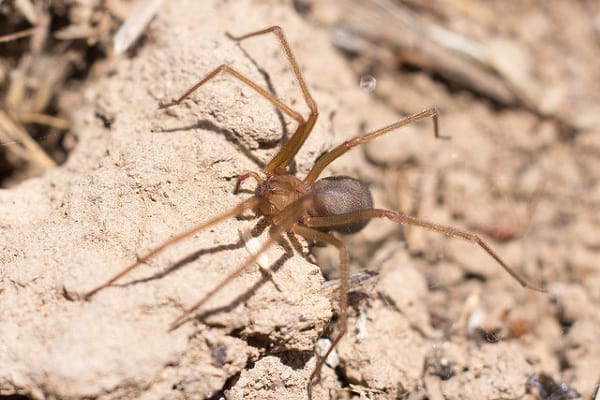
The desert recluse (Loxosceles deserta) is a rare and venomous spider that belongs to the family Sicariidae, which are also known as recluse spiders. The spider has a brown or tan body, with a dark violin-shaped mark on its cephalothorax, and six eyes arranged in three pairs. The female is larger than the male, reaching up to a third of an inch in body length, while the male is about a quarter of an inch.
The desert recluse is one of the most dangerous spiders in California, as its bite can cause necrosis, which is the death of skin tissue. The bite may also cause fever, chills, rash, and kidney failure. The spider is very secretive and will only bite if disturbed or threatened. The spider is usually found in dry and isolated areas, such as deserts, caves, and mines.
Do you know about What Do Owls Mean in Dreams?
Do You Need Help Evicting Unwanted Spiders in California Homes and Businesses?
If you have a spider problem in your home or business, you may need professional help to get rid of them safely and effectively. Spiders can be hard to identify, and some of them may pose a health risk to you and your family. You may also want to prevent future infestations by sealing any cracks or gaps where spiders can enter and removing any clutter or debris where spiders can hide.
To find a reliable and experienced pest control service in your area, you can use the search tool on this website. Just enter your zip code and the type of pest you need help with. You will get a list of qualified and trusted pest control experts near you, who can offer you a free quote and a fast service. You can compare their ratings, reviews, and prices, and choose the one that suits your needs and budget. Don’t let spiders ruin your peace of mind and comfort. Contact a pest control professional today and enjoy a spider-free home or business.
Frequently Asked Questions
Q1: Are squirrels common in California?
Yes, squirrels are common in California. There are five types of tree squirrels and four types of ground squirrels that live in California. Some of them are native to the state, while others are introduced from other regions. Squirrels can be found in various habitats, such as forests, fields, gardens, parks, and urban areas.
Q2: Are squirrels pests in California?
Squirrels can be considered pests in California, depending on the perspective. Some people enjoy watching squirrels and appreciate their role in seed dispersal and forest health. However, some people dislike squirrels and regard them as nuisances and invaders. Squirrels can cause damage to crops, plants, trees, wires, pipes, and buildings. They can also carry diseases and parasites that can affect humans and pets.
Q3: What eats squirrels in California?
Squirrels have many predators in California, both natural and human. Some of the animals that eat squirrels in California are hawks, owls, eagles, falcons, bobcats, foxes, coyotes, weasels, snakes, feral cats, and dogs. Some people also hunt squirrels in California for food or sport, using firearms, traps, or dogs.
Q4: How long do California squirrels live?
The lifespan of squirrels in California varies depending on the species and the environment. In general, tree squirrels live longer than ground squirrels and captive squirrels live longer than wild squirrels. The average lifespan of tree squirrels in California ranges from 6 to 18 years, while the average lifespan of ground squirrels in California ranges from 3 to 6 years.
